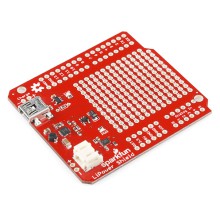LiPower Shield
Is there anything an Arduino can't do? Well, for one,
most of them can't be powered directly from a 3.7V
LiPo battery; much less charge and monitor that battery.
The LiPower Shield takes care of this by combining the functionality
of two of our favorite battery power boards: the Power Cell and the Fuel Gauge.
The LiPower Shield allows you to connect a 3.7V single cell
Lithium polymer battery which it will boost up to 5V and connect to the Arduino board's 5V pin.
The on-board MAX17043G+U IC is connected to the I2C lines (A4 and A5)
so that your project can monitor it's own power supply.
The configurable alert interrupt pin on the MAX17043G+U IC is
broken out to D3 which will activate when the LiPo gets to 32% or lower.
The charging circuit is configured to charge the LiPo at 100mA but by
adding a resistor to the supplied through-holes you can boost this to 500mA.
There is a mini-USB port on the shield which allows you to charge
the battery from a USB power source or you can supply a separate
regulated 5V source on the "charge" header.

Note: We've decided to leave the power indicator LED (LED1) and its current limiting resistor (R3)
off this board, as they were producing a significant drain on the battery.
Please be aware that your board will have a few, shiny, unpopulated pads.
Note: There is a known hardware bug that will allow the LiPo to discharge
below the point where the charging circuit will revive it.
Thanks to the on-board fuel gauge, however, some
clever programming could keep your project from draining the battery as it gets too low.
תיעוד:
- Schematic
- Eagle Files
- Datasheet (MAX17043G+U)
- Datasheet (MCP73831T)
- Datasheet (TPS61200)
- Example Code









